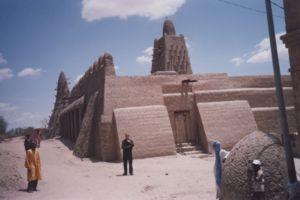Trickle-down in a Parched, Consumption-Driven World
"Ethos Water, a tiny startup acquired by Starbucks in April, will donate five cents for every $1.80 bottle of water that it sells to fund drinking water projects in poor countries in Africa, Asia and Latin America.
[Company President Peter] Thum got the idea for Ethos Water while working as a consultant for McKinsey & Co. in South Africa, studying the wine business. "I ended up spending a lot of time around people who were very poor," he says. "It changed the way that I saw things." He turned for help to Jonathan Greenblatt, his former roommate at Northwestern's Kellogg School of Management, who had worked on development issues for the Clinton administration.
In 2003, they launched Ethos Water and a sister nonprofit to distribute money to water development efforts. "We had never started a company, let alone a nonprofit, or ever done anything in the bottled water industry," Thum says. Most investors turned down their pitches, but Pierre Omidyar, the eBay founder who now runs a network of nonprofits and businesses with social purposes, became a key backer. Before the Starbucks deal, Ethos Water helped finance water projects in Bangladesh, Democratic Republic of Congo, Ethiopia, India and Kenya.
By selling to Starbucks, they diluted their mission some. Instead of giving away the bulk of their profits, they will give away five cents per bottle. But Thum and Greenblatt say the Starbucks deal will enable them to deliver more money, more quickly, to water projects that will help children, and that's what counts. Starbucks has promised to contribute at least $1 million to humanitarian water projects in 2006, and says it hopes to give away at least $10 million over the next five years."
Source: Marc Gunther "Starbucks Stirs Up the Water Market"
Fortune.com August 4, 2005

Timbuktu, Mali. Home of the prestigious Koranic Sankore University and other madrasas, Timbuktu was an intellectual and spiritual capital and a centre for the propagation of Islam throughout Africa in the 15th and 16th centuries. Its three great mosques, Djingareyber, Sankore and Sidi Yahia, recall Timbuktu's golden age. Although continuously restored, these monuments are today under threat from desertification.(A UNESCO World Heritage Site since 1988)
Photo credit: Professor Grzegorz W. Kolodko
http://kolodko.tiger.edu.pl
[Company President Peter] Thum got the idea for Ethos Water while working as a consultant for McKinsey & Co. in South Africa, studying the wine business. "I ended up spending a lot of time around people who were very poor," he says. "It changed the way that I saw things." He turned for help to Jonathan Greenblatt, his former roommate at Northwestern's Kellogg School of Management, who had worked on development issues for the Clinton administration.
In 2003, they launched Ethos Water and a sister nonprofit to distribute money to water development efforts. "We had never started a company, let alone a nonprofit, or ever done anything in the bottled water industry," Thum says. Most investors turned down their pitches, but Pierre Omidyar, the eBay founder who now runs a network of nonprofits and businesses with social purposes, became a key backer. Before the Starbucks deal, Ethos Water helped finance water projects in Bangladesh, Democratic Republic of Congo, Ethiopia, India and Kenya.
By selling to Starbucks, they diluted their mission some. Instead of giving away the bulk of their profits, they will give away five cents per bottle. But Thum and Greenblatt say the Starbucks deal will enable them to deliver more money, more quickly, to water projects that will help children, and that's what counts. Starbucks has promised to contribute at least $1 million to humanitarian water projects in 2006, and says it hopes to give away at least $10 million over the next five years."
Source: Marc Gunther "Starbucks Stirs Up the Water Market"
Fortune.com August 4, 2005

Timbuktu, Mali. Home of the prestigious Koranic Sankore University and other madrasas, Timbuktu was an intellectual and spiritual capital and a centre for the propagation of Islam throughout Africa in the 15th and 16th centuries. Its three great mosques, Djingareyber, Sankore and Sidi Yahia, recall Timbuktu's golden age. Although continuously restored, these monuments are today under threat from desertification.(A UNESCO World Heritage Site since 1988)
Photo credit: Professor Grzegorz W. Kolodko
http://kolodko.tiger.edu.pl


0 Comments:
Post a Comment
<< Home